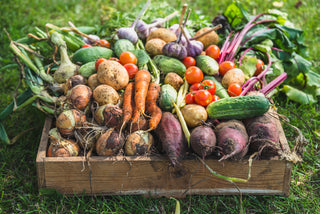Starting or maintaining a community herb garden can be one of the most rewarding and practical projects for any neighborhood or group. Herbs are not only easy to grow, but they also provide fresh ingredients for cooking, improve the local environment, and foster a sense of community. Whether you are growing herbs in containers or raised beds, understanding which herbs work well together and how to care for them is key to creating a thriving garden.
All of the herbs mentioned below are available from Quality Plants & Seedlings (QPS), a trusted source for high-quality, sustainably grown plants. If you're looking to start or expand your community herb garden, QPS offers a wide variety of herbs to suit all needs.
Herb Planting Guide for Community Gardens
| Herb | Watering Needs | Soil Type | Notes | Planting Compatibility | Spacing (mm) | Cut and Regrow |
|---|---|---|---|---|---|---|
| Basil | Moderate | Well-drained, rich | Best grown with tomatoes and peppers; requires warm weather. | Can be planted with tomatoes, oregano, and peppers. | 300 mm | Yes, regularly (trim leaves and tips) |
| Mint | Moderate to High | Moist, well-drained | Grows quickly; best in containers to prevent spreading. | Should be planted in containers to avoid spreading. | 450 mm (if in ground) | Yes, but keep in check to prevent overgrowth |
| Parsley | Moderate | Well-drained, slightly acidic | Biennial; great for year-round harvest. | Works well with chives, basil, and cilantro. | 250 mm | Yes, regrows after cutting leaves |
| Chives | Moderate | Well-drained, loamy | Hardy, attracts beneficial insects, pest-repellent. | Can be planted with parsley, basil, and tomatoes. | 200 mm | Yes, cut leaves frequently to encourage regrowth |
| Thyme | Low to Moderate | Well-drained, rocky or sandy | Drought-tolerant, excellent for savory dishes. | Can grow with rosemary, oregano, and sage. | 300 mm | Yes, trim tops to encourage bushier growth |
| Rosemary | Low to Moderate | Well-drained, sandy or loamy | Low-maintenance once established; drought-tolerant. | Can be planted with thyme, oregano, and sage. | 450 mm | Yes, trim stems for regrowth |
| Oregano | Low to Moderate | Well-drained, sandy or loamy | Great for containers; perfect for Mediterranean dishes. | Works well with basil, thyme, and rosemary. | 300 mm | Yes, cut leaves to encourage new growth |
Below, we’ve compiled a list of popular herbs that are perfect for community gardens, along with planting tips, watering needs, and whether they can be cut and regrown for continuous harvests.
1. Basil
- Watering Needs: Moderate
- Soil Type: Well-drained, rich
- Notes: Best grown with tomatoes and peppers; thrives in warm weather.
- Planting Compatibility: Can be planted with tomatoes, oregano, and peppers.
- Spacing: 300 mm
- Cut and Regrow: Yes, regularly (trim leaves and tips to encourage new growth).
Basil is a must-have in any herb garden. It's perfect for adding to salads, sauces, and pasta dishes. Plant it alongside tomatoes for a classic pairing, and enjoy its fragrant leaves all summer long. Regular trimming will encourage a bushier plant, giving you more harvests.
2. Mint
- Watering Needs: Moderate to High
- Soil Type: Moist, well-drained
- Notes: Grows quickly and can be invasive. Best grown in containers to prevent spreading.
- Planting Compatibility: Should be planted in containers to avoid spreading.
- Spacing: 450 mm (if in the ground)
- Cut and Regrow: Yes, but keep in check to prevent overgrowth.
Mint is an incredibly versatile herb, ideal for teas, desserts, and garnishes. While mint is hardy and fast-growing, it's best grown in containers to avoid it overtaking your garden. You can regularly cut back mint to encourage fresh growth and keep it manageable.
3. Parsley
- Watering Needs: Moderate
- Soil Type: Well-drained, slightly acidic
- Notes: Biennial; great for year-round harvest.
- Planting Compatibility: Works well with chives, basil, and cilantro.
- Spacing: 250 mm
- Cut and Regrow: Yes, regrows after cutting leaves.
Parsley is an essential herb for garnish and flavor. It’s a great addition to any dish, from soups to salads. Parsley is a biennial, so you can harvest it regularly for at least a year, and it will continue to grow back after each cut.
4. Chives
- Watering Needs: Moderate
- Soil Type: Well-drained, loamy
- Notes: Hardy and pest-repellent. Attracts beneficial insects.
- Planting Compatibility: Can be planted with parsley, basil, and tomatoes.
- Spacing: 200 mm
- Cut and Regrow: Yes, cut leaves frequently to encourage regrowth.
Chives are a great addition to community gardens due to their resilience and pest-repellent properties. They grow well with parsley and basil, adding both beauty and functionality to your garden. Regular cutting will keep them fresh and healthy, promoting continuous regrowth.
5. Thyme
- Watering Needs: Low to Moderate
- Soil Type: Well-drained, rocky or sandy
- Notes: Drought-tolerant and great for savory dishes.
- Planting Compatibility: Can grow with rosemary, oregano, and sage.
- Spacing: 300 mm
- Cut and Regrow: Yes, trim tops to encourage bushier growth.
Thyme is a low-maintenance herb that thrives in hot, dry conditions. It's perfect for Mediterranean dishes and pairs well with other drought-tolerant herbs like rosemary and oregano. Regular trimming will encourage a fuller plant.
6. Rosemary
- Watering Needs: Low to Moderate
- Soil Type: Well-drained, sandy or loamy
- Notes: Low-maintenance once established; drought-tolerant.
- Planting Compatibility: Can be planted with thyme, oregano, and sage.
- Spacing: 450 mm
- Cut and Regrow: Yes, trim stems for regrowth.
Rosemary is a staple herb for cooking, especially for meats and Mediterranean cuisine. It’s hardy once established and requires little maintenance. Cutting back rosemary regularly will encourage fresh, flavorful growth.
7. Oregano
- Watering Needs: Low to Moderate
- Soil Type: Well-drained, sandy or loamy
- Notes: Great for containers; perfect for Mediterranean dishes.
- Planting Compatibility: Works well with basil, thyme, and rosemary.
- Spacing: 300 mm
- Cut and Regrow: Yes, cut leaves to encourage new growth.
Oregano is a robust herb that thrives in dry conditions. It’s perfect for use in Italian and Greek dishes, and it pairs well with thyme and rosemary. Like rosemary, oregano benefits from regular cutting to keep it producing fresh leaves.
8. Coriander
- Watering Needs: Moderate to High
- Soil Type: Well-drained, moist
- Notes: Fresh leaves are used as cilantro; seeds are used as coriander spice. Prefers cooler weather.
- Planting Compatibility: Can be planted with parsley, chives, and basil.
- Spacing: 250 mm
- Cut and Regrow: Yes, but it bolts quickly; regrows less often.
Coriander is another herb with dual uses: the leaves are known as cilantro, and the seeds are used as a spice. Coriander prefers cooler temperatures and can be a bit finicky, as it bolts (goes to seed) quickly in hot weather. However, it can be cut early and harvested frequently for fresh cilantro.
9. Sage
- Watering Needs: Low to Moderate
- Soil Type: Well-drained, sandy or loamy
- Notes: Ideal for savory dishes; drought-tolerant.
- Planting Compatibility: Plant with thyme, rosemary, and oregano.
- Spacing: 450 mm
- Cut and Regrow: Yes, cut leaves to encourage new growth.
Sage is another essential herb for any community garden. It’s perfect for hearty dishes like stews and roasts. Sage is low-maintenance and drought-tolerant once established, and regular cutting will help it stay healthy and produce fresh leaves.
10. Lemon Balm
- Watering Needs: Moderate
- Soil Type: Well-drained, moist
- Notes: Spreads quickly; great for teas and pests.
- Planting Compatibility: Can be planted with oregano, thyme, and rosemary.
- Spacing: 300 mm
- Cut and Regrow: Yes, regrows quickly after cutting.
Lemon balm is a refreshing herb known for its lemony fragrance. It can be used in teas and as a natural pest repellent. Be mindful that it can spread quickly, so it's best planted in a contained space. Regular cutting will help keep it manageable.
11. Dill
- Watering Needs: Moderate
- Soil Type: Well-drained, sandy
- Notes: Fast-growing; attracts pollinators like bees.
- Planting Compatibility: Plant with coriander, parsley, and cilantro.
- Spacing: 300 mm
- Cut and Regrow: Yes, but short-lived; regrows once if not allowed to flower.
Dill is a fast-growing herb that attracts beneficial pollinators to your garden. While it can be short-lived and bolts quickly (goes to seed), it’s still a great herb for pickling and salads. Cutting it before it flowers will extend its lifespan and encourage more growth.
12. Tarragon
- Watering Needs: Low to Moderate
- Soil Type: Well-drained, loamy
- Notes: Perfect for French cuisine; drought-tolerant.
- Planting Compatibility: Works well with thyme, rosemary, and oregano.
- Spacing: 450 mm
- Cut and Regrow: Yes, regrows after cutting stems.
Tarragon is an aromatic herb used in French cooking, particularly in sauces and with chicken. Like other Mediterranean herbs, it’s drought-tolerant and regrows after cutting stems.
13. Fennel
- Watering Needs: Moderate
- Soil Type: Well-drained, sandy
- Notes: Tall plant, ideal for attracting pollinators.
- Planting Compatibility: Best grown separately due to its height.
- Spacing: 500 mm
- Cut and Regrow: Yes, but regrows slower and less frequently.
Fennel is a striking, tall herb that attracts pollinators. While it can be a bit slower to regrow, it still makes a great addition to any herb garden, especially for its unique flavor and ornamental appeal.





